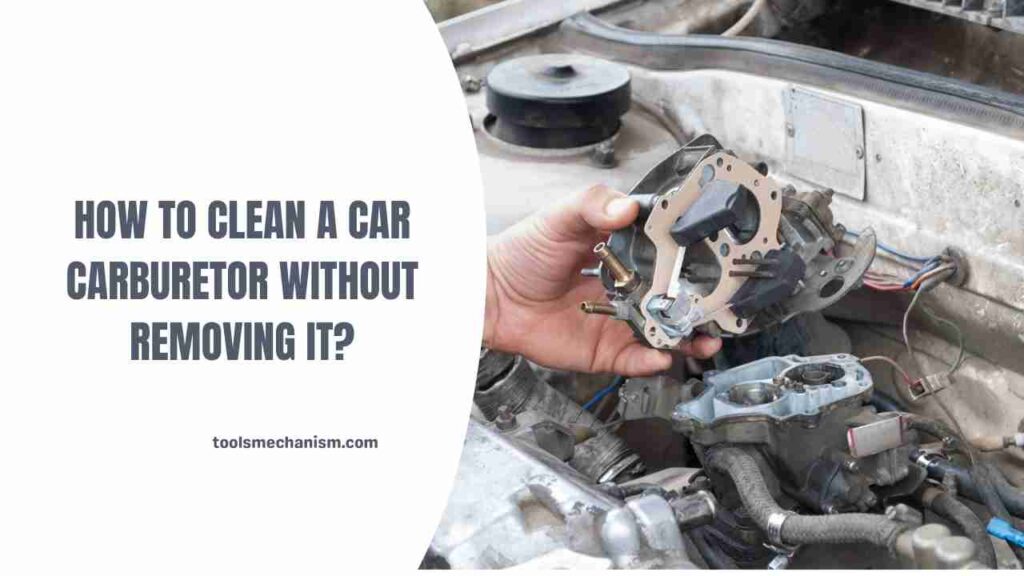A car with no engine isn’t going to be of use to anyone, and one of the most vital organs in your car engine is the carburetor. To maintain optimum performance from your vehicle, the need to clean this valuable piece cannot be emphasized enough.
Maintaining a clean carburetor will contribute to your engine running properly as well as protecting from corrosion. This will eventually save you money because you won’t have to replace parts, and because you get better gas mileage and a more efficient engine in the process.
How to Clean a Car Carburetor Without Removing It?
If you’re not a mechanic or do not have a great deal of experience with car engines, the thought of removing a carburetor to clean it may indeed seem daunting. There are lots of all pieces and parts that may be mislaid in the disassembling making reassembly confusing and unsuccessful.
Not to worry. It’s better not to take things apart as it may be difficult to remember exactly how to replace them.
All things considered it is pretty simple to clean your car carburetor without removing it from its position. This is a procedure that is used all the time for the cleaning of car carburetors. Here are some easy steps to follow.
- Buy a quality spray carburetor cleaner.
- Begin with the removal of the bowls. These are positioned near the bottom of the carburetor.
- Begin to spray the carburetor cleaning product up into the inside of the carburetor. The cleaner must make it inside the carburetor to be effective. Wait for several minutes.
- Repeat step 3 to ensure that the entire carburetor has received the cleaning spray. A partial cleaning will not obtain the desired effect.
- Now you can return the bowls to their position. To be sure that the bowls are not contributing to the problem, you may want to replace them with new ones.
- Start your car engine up, listen to the motor running, drive it a bit, and evaluate its performance. If you are not satisfied, you may want to repeat the process.
Carburetor Grime
The continuous intake of air can dry out your fuel to some extent, creating a sticky, sappy substance that clings to the carburetor walls and gradually will build up.
Also, if you don’t use your auto frequently, the gasoline left in the gas tank may begin to thicken and create some difficulty for the carburetor to work efficiently. Carburetor connections to both the choke plates and the throttle may begin to stick if there’s a lot of grime.
When Should the Carburetor Be Cleaned?
For those of us who realize the importance of cleaning the carburetor, the logical first question will be “When?” Actually, your car will give you a few signs that cleaning may be needed. Let’s consider what your car’s performance may be telling you.
Your car won’t start: This is an important sign that something is wrong. If the carburetor is exceptionally dirty and grimy, it will negatively affect the engine’s performance. The presence of lots of grime in your carburetor will impede the correct passage of the combination of air and fuel into your car’s engine. One result will be that your car won’t start.
So, one thing to immediately consider if your engine doesn’t start up is a dirty carburetor.
A lean running engine: The terms “lean running” in referral to a car engine signify that the fuel and air combination is not balanced. The general rule is that the air ratio to the fuel should sit between 12:1 and 15:1. If this ratio is not maintained and your engine finds it self with either too much air or too little fuel, you may hear a popping or sputtering sound.
This also can be construed as your car telling you that its carburetor needs to be cleaned. The grime may be blocking the fuel.
A rich running engine: This will be the opposite of a lean running engine. Again, this is a problem of imbalance in the air to fuel ratio. Here there will be too little air and much too much fuel. If black smoke is emitted from your exhaust pipe, this is a telltale sign that the car’s carburetor is filthy.
Your car engine floods: Ouch! If the fuel bowl contains too much dirt, it may block the needle valve. As a result, the valve won’t close correctly, and the fuel will flow right into the carburetor and then right out of the bowl vents flooding your engine.
Since the air/fuel ratio is incorrect, the spark plugs will most likely get wet. Here your engine is telling you that it’s time to clean your carburetor.
Smell: The carburetor may emanate an odor similar to turpentine or chemicals that is different from gasoline.
How Often Should a Car Carburetor be Cleaned?
Approximately every 3,000 miles you drive, the carburetor should be cleaned. If you do not use your car very much and drive less than 3,000 miles in a six-month period, then clean the carburetor at least once every six months.
Professional mechanics and auto repair businesses emphasize that keeping your car carburetor clean is essential to the engine’s performance. It is important to clean the carburetor regularly, and on a schedule, just as you would other car maintenance procedures.
 Conclusion
Conclusion
Now that you have a procedure that will allow you to clean your car carburetor without removing it, and you have an idea of when and how often you will need to clean it, we hope that you will insert this in your regular car maintenance programming. Regular DIY carburetor cleanings will save you some trips to the auto repair shop or to your trusted mechanic.
Through regular maintenance and cleaning, grime and dirt accumulation will be kept manageable, and your car will give you great performance, good gas mileage, and in the end, save you both time and money.

